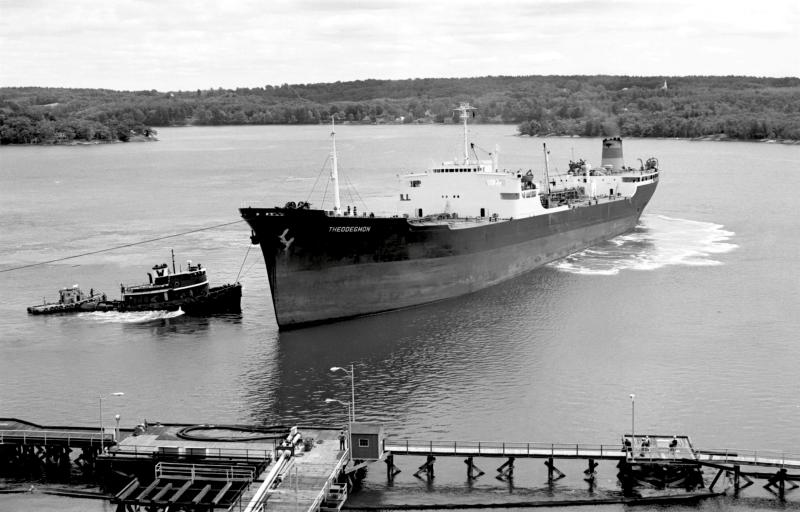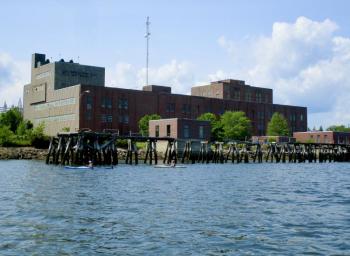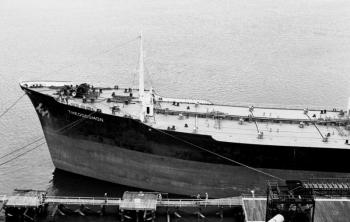There was a time, much to the chagrin of lobstermen, when huge tanker ships laden with fuel oil journeyed up the waters of the Sheepscot River. Their destination was Central Maine Power Company’s Mason Station facing Wiscasset harbor on Birch Point. Notwithstanding the resulting loss of lobster gear, it was awe inspiring watching ships of this size being maneuvered by tugboats around Westport Island and into the harbor. It’s a sight only to be remembered, because the power plant shut down for good over 30 years ago.
The first time I witnessed a tanker’s arrival was in March 1980; I’d been working for about a year as a reporter for the Boothbay Register-Wiscasset Newspaper. The colossal ship’s arrival was really big news, no pun intended, and of course made the front page. The headline read: “Mason Station Gets Refueling Last Weekend.”
A smaller “kicker” ran over the headline stating, “Close To $2 Million Worth Of No. 6 Oil Delivered.” Above the story was a picture of the massive oil tanker making its way through the roiling river channel separating the southern tip of Westport Island from Davis Island, Edgecomb. The news article, written by me, didn’t make mention of the loss of lobster gear as the tanker made its way slowly but deliberately upriver. The story actually began on March 7, a sunny Friday afternoon. Benny Rines Jr., a Wiscasset selectman, had stopped by to see me. I was renting a place on Davis Island and Ben and I were on the back porch that overlooked the river. I recall him saying he enjoyed reading my articles in the Wiscasset Newspaper. “But how do you find stories to write about every week?” he asked. I replied rather matter-of-factly, that news had a way of finding me. It was just at that moment, as if on cue an enormous oil tanker came around the tip of Westport Island. “Wow, you weren’t kidding!” said Benny. A minute later, camera in hand, I was taking pictures.
The tanker, I learned was the Theodegmon and stretched 660 feet from stem to stern, about the length of two football fields. Three tugboats berthed at Bath and owned by Capt. Elliot Winslow were needed to ease the ship through “The Narrows” as it’s known and eventually alongside the station’s pier. The tanker was delivering 88,000 barrels of heavy crude to the generating station. That was about a “quarter of the station’s fuel holding capacity” according to what I was told by Nate Whitaker, Mason Station’s superintendent. I’d gotten to know Nate and Linda his wife pretty well. They resided on the southern part of Westport Island near East Shore Road with their two sons, Matt and Tommy, who both attended Wiscasset schools. Tommy had played soccer for me when I coached the high school’s soccer team and both boys were standouts on the wrestling team. When I got in touch with Nate about the tanker’s arrival he said CMP had paid $24 a barrel for the oil, which was a fairly high price in the late 1970s. Of course this was during the so-called “Energy Crisis” a time when gasoline and oil prices were soaring across the country. Nate went on to say next time I could get some better pictures of the tanker from the roof of the power station.
Just a few months later I took Nate up on that offer. On Saturday, July 12, a gray, overcast day, I was standing on the roof of Mason Station. With me was Phil Clark, Mason Station’s assistant superintendent, watching as the Theodegmon made another appearance in the harbor. She arrived on schedule just before noontime on the morning’s high tide, flanked again by a trio of Winslow tugs which maneuvered the ship to the station’s pier. On this morning the tanker was delivering 60,000 barrels of fuel oil. Also on Mason Station’s roof that day was Brad Amazeen, who’d been hired to videotape the tanker’s arrival for a training film CMP was producing for its workers.
When Mason Station first opened in 1942, the plant had burned coal to fired its generators that was shipped by rail. A railroad spur was laid to the power plant from the former Maine Central RR starting near the old whistle stop. The spur included construction of a huge wooden trestle to span Ward Brook that can still be seen today. Later, Mason Station was converted to burn oil which was a much cleaner fuel source. In the 1980s, CMP was using Mason Station as a “stand-by generating facility” bringing it online to supplement the needs of New England Power Pool. In spite of its age, Clark said the station was still a very productive power station and in excellent operating condition. The plant’s biggest liability he told me was the cost of oil. In 1975, #6 crude, the fuel the plant burned, was selling for less than $2 a barrel but because of the Energy Crisis, the cost of crude had skyrocketed more than 600%. You might be surprised to learn that CMP had purchased the oil the Theodegmon was carrying from the South American country of Venezuela. Times have certainly changed since then. I recall too, CMP officials telling me next time they would reach out to local lobstermen alerting them of a pending oil delivery so they might remove their gear from the river channel.
The Theodegmon began off-loading its oil to the station’s above ground storage tanks at about 2 p.m. finishing that evening. The ship cast off at 7 a.m. the following morning. The tanker had divided its oil cargo with the William F. Wyman generating station located on Cousin’s Island in Yarmouth. Mason Station was decommissioned in 1990-91, its fuel storage tanks having been removed years ago. As for the three-story brick building housing the station, its fate is yet to be determined. Perhaps, someday, someone will figure out how best to make use of this property.
I’ve included a picture I took that morning from Mason Station’s roof so you might appreciate the Theodegmon’s size. Not surprising an oil tanker’s arrival often caused motorists on the old Wiscasset bridge to slow, or even stop to watch. I used a Nikon FM 35mm camera with a 50mm lens to take my pictures, the resulting images being close to the way you’d see this with your own eyes. I was using 400 speed, Kodak Tri-X black & white film, which I later processed in my darkroom. Sharing these images with you after so many years was made possible by my son, Jason Di Vece of Vermont, who recently copied them in digital format. Take it from me when I say they look as good now as when they were first taken.
Phil Di Vece earned a B.A. in journalism studies from Colorado State University and an M.A. in journalism at the University of South Florida. He is the author of three Wiscasset books and is a frequent news contributor to the Boothbay Register-Wiscasset Newspaper. He resides in Wiscasset. You can contact him at pdivece@roadrunner.com



































